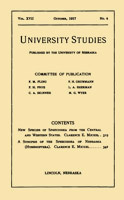University Studies of the University of Nebraska
Date of this Version
1-1918
Citation
UNIVERSITY STUDIES VOL. XVIII JANUARY-APRIL, 1918 Nos. 1-2
Abstract
A series of intensive investigations of the ecological features of the tension zone between prairie and woodland in the Mississippi valley was begun by Weaver and Thiel in 1915. These studies were continued for two seasons in Minnesota and were also extended to the prairies of eastern Nebraska in 1916. These investigations represent the first attempt to attack the prairie-forest problem on a comprehensive scale by means of the quantitative methods of modern ecology. Some of the results secured from these studies have been published as the first paper of a series planned to deal with critical investigations in the ecology of the prairie province. The above studies were continued and considerably extended in the Nebraska area by the authors of the present paper during the year 1917. The object of the present paper is to record the results and conclusions derived from another season's investigations of some of • the fundamental problems connected with the ecology of the areas lying within the vegetative borderlands between the prairies and the woodlands of the Missouri valley in Nebraska. This contribution is a natural sequel to the paperl by Weaver and Thiel noted in a previous paragraph. Results are here recorded from our old stations in the prairie and woodland in the vicinity of Lincoln and also many additional data and materials are presented from a new series of stations established in 1917 near Peru, on the Missouri River. It has been demonstrated that the latter stations exhibit conditions which are in all cases much more mesophilous than obtain at our corresponding Lincoln stations. Contrasts between the vegetative conditions characteristic of the two areas are remarkable and ecologically very significant although the areas are only about 60 miles apart. These contrasts are clearly shown to be due to striking differences in both edaphic and climatic factors in the two series of stations. This paper also contains many experimental data bearing upon the successional sequenct! of the various woodland types as commonly developed in the region about Peru.
Included in
Biology Commons, Botany Commons, Ecology and Evolutionary Biology Commons, Forest Sciences Commons


Comments
PUBLISHED BY THE UNIVERSITY OF NEBRASKA